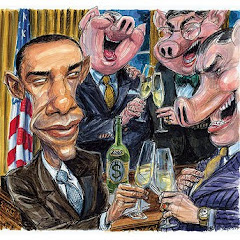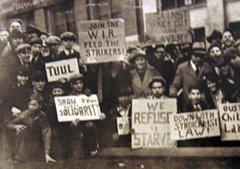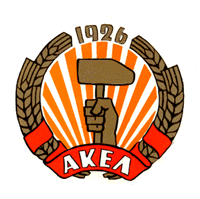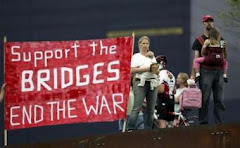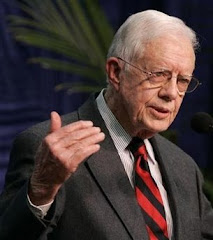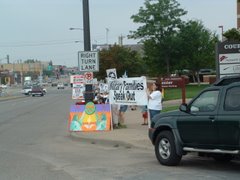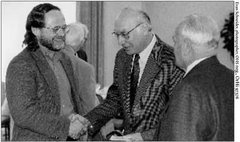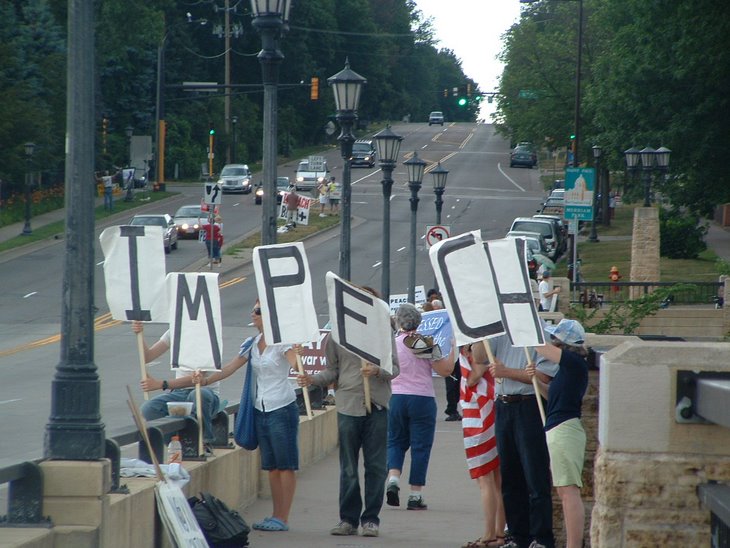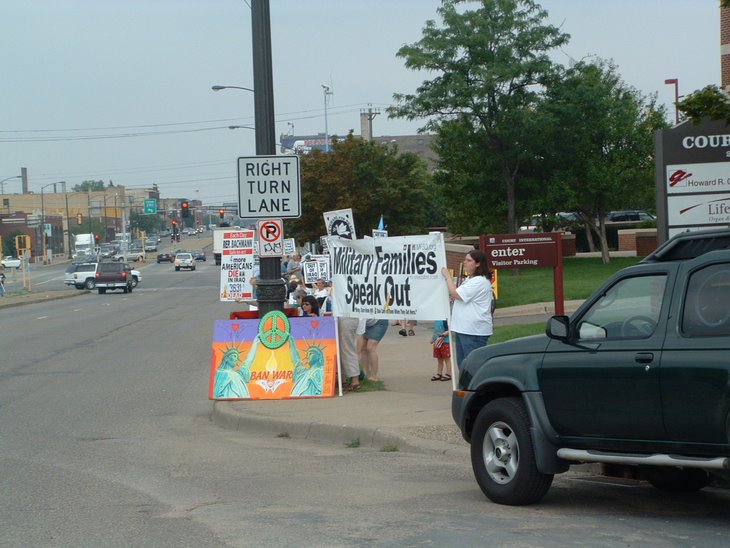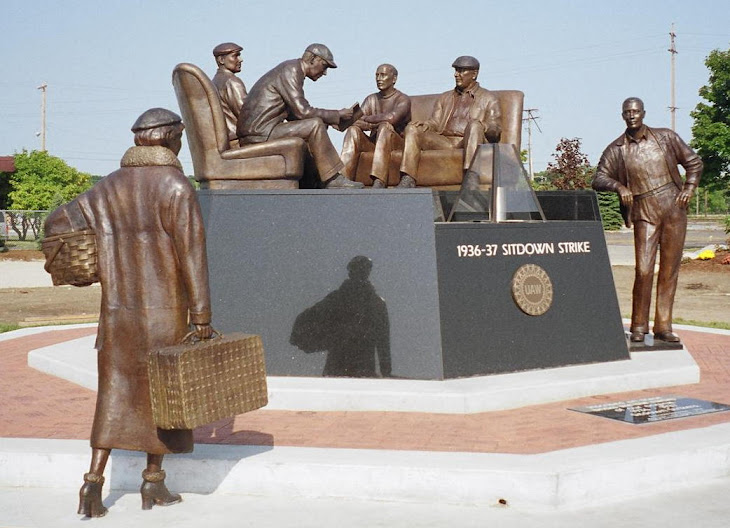Wednesday, March 18, 2009
Deal struck in Windsor auto parts plant blockade
Deal struck in Windsor auto parts plant blockade
http://www.calgaryherald.com/business/fp/story.html?id=1402042
By Donald McArthur, Canwest News ServiceMarch 18, 2009 5:01 PM
WINDSOR, Ont. — Chrysler should soon be able to remove vital tooling from a pair of auto parts plants after a tentative deal was inked Wednesday with displaced workers, who had been maintaining blockades since the suppliers abruptly closed last week.
The deal was announced from the bed of a Dodge pickup truck by CAW President Ken Lewenza as he addressed a crowd of about 500 gathered for a workers’ rights rally outside Aradco.
“We just struck an agreement not less than two or three minutes ago that we have in writing that provides some support, not all the support, for the membership,” said Mr. Lewenza, eliciting cheers from the crowd.
“But at the end of the day, where we started on Monday and where we’re at today is 10 times further than we ever were and what we’d ever get.”
Workers with Aradco and its sister plant, Aramco, voted 64% Monday to reject an offer from Chrysler that would have provided them with $205,000 — the equivalent of about four weeks vacation pay. Details of the new offer will not be disclosed until they are presented to the workers Thursday morning.
Workers say they are owed about $1.7-million in back pay and vacation pay and severance and termination pay by U.S. based Catalina Precision Products, which owns Aradco and Aramco, but they fear they won’t be paid. The deal with Chrysler would end the blockade and allow the automaker to retrieve tooling from inside the plants, which closed last week when Chrysler cancelled their supply contracts.
About a dozen workers who stormed the shuttered Aradco plant Tuesday night were celebrated as courageous heroes by Mr. Lewenza and other speakers, including Windsor-Tecumseh NDP MP Joe Comartin.
The workers spent the night in the plant and emerged on the roof waving CAW flags as Mr. Lewenza addressed the crowd. One of them carried a cardboard placard reading “Fighting Back Makes A Difference.”
“These guys are heroes,” said Paul Miller, an NDP member of provincial parliament who has introduced a private member’s bill championing the rights of workers.
The workers who overnighted in the plant were relieved the ordeal was over and expressed hope that the publicity surrounding their stand would prompt legislative changes to guarantee workers severance payments in the event of sudden plant closures.
“If it changes the law and protects the Canadian worker, it was well worth it,” said Mike Melo, the CAW plant chair for Aramco. “The law needs to be changed for the Canadian workers so they get paid before anyone else gets paid.”
Windsor Star
© Copyright (c) National Post
http://www.calgaryherald.com/business/fp/story.html?id=1402042
By Donald McArthur, Canwest News ServiceMarch 18, 2009 5:01 PM
WINDSOR, Ont. — Chrysler should soon be able to remove vital tooling from a pair of auto parts plants after a tentative deal was inked Wednesday with displaced workers, who had been maintaining blockades since the suppliers abruptly closed last week.
The deal was announced from the bed of a Dodge pickup truck by CAW President Ken Lewenza as he addressed a crowd of about 500 gathered for a workers’ rights rally outside Aradco.
“We just struck an agreement not less than two or three minutes ago that we have in writing that provides some support, not all the support, for the membership,” said Mr. Lewenza, eliciting cheers from the crowd.
“But at the end of the day, where we started on Monday and where we’re at today is 10 times further than we ever were and what we’d ever get.”
Workers with Aradco and its sister plant, Aramco, voted 64% Monday to reject an offer from Chrysler that would have provided them with $205,000 — the equivalent of about four weeks vacation pay. Details of the new offer will not be disclosed until they are presented to the workers Thursday morning.
Workers say they are owed about $1.7-million in back pay and vacation pay and severance and termination pay by U.S. based Catalina Precision Products, which owns Aradco and Aramco, but they fear they won’t be paid. The deal with Chrysler would end the blockade and allow the automaker to retrieve tooling from inside the plants, which closed last week when Chrysler cancelled their supply contracts.
About a dozen workers who stormed the shuttered Aradco plant Tuesday night were celebrated as courageous heroes by Mr. Lewenza and other speakers, including Windsor-Tecumseh NDP MP Joe Comartin.
The workers spent the night in the plant and emerged on the roof waving CAW flags as Mr. Lewenza addressed the crowd. One of them carried a cardboard placard reading “Fighting Back Makes A Difference.”
“These guys are heroes,” said Paul Miller, an NDP member of provincial parliament who has introduced a private member’s bill championing the rights of workers.
The workers who overnighted in the plant were relieved the ordeal was over and expressed hope that the publicity surrounding their stand would prompt legislative changes to guarantee workers severance payments in the event of sudden plant closures.
“If it changes the law and protects the Canadian worker, it was well worth it,” said Mike Melo, the CAW plant chair for Aramco. “The law needs to be changed for the Canadian workers so they get paid before anyone else gets paid.”
Windsor Star
© Copyright (c) National Post
Workers to rally outside occupied Windsor plant
Workers to rally outside occupied Windsor plant
http://www.windsorstar.com/Business/Workers+rally+outside+occupied+Windsor+plant/1402031/story.html
By Donald McArthur, The Windsor StarMarch 18, 2009

Canadian Auto Workers Union Local 195 President Gerry Farnham, left, and Windsor Police Sgt. Tony Garro converse as a large crowd of CAW supporters and employees block the main entrance of the Aradco Management Ltd. plant in Windsor, Ont. on Tuesday. On Wednesday, they continued to lobby the plants' owners for wages and benefits they claim are owed to them.Photograph by: Jason Kryk, Windosr StarWINDSOR, Ont. — A group of Aradco workers here continued to occupy a shuttered auto-parts plant Wednesday morning as union organizers geared up for an afternoon rally for workers' rights outside the plant.
Canadian Auto Workers President Ken Lewenza is scheduled to speak at the 3:30 p.m. rally.
The workers stormed the plant Tuesday night intent on stopping Chrysler from removing parts and tooling inside. The union was reluctant to divulge numbers, but said "more than a handful" of workers remained inside.
Gerry Farnham, president of CAW Local 195, said at the scene Wednesday the workers plan on occupying the plant until issues surrounding outstanding severance and termination pay are resolved.
"You have workers in there who have never been in trouble with the law. They're scared but they're willing to do this to get what they are entitled to," said Farnham. "They're not coming out until we can get this issue resolved. They are strong and they are resolved."
About 80 workers with Aradco and its sister plant, Aramco, were told not to report to work a week ago Monday after Chrysler terminated its contract with the two suppliers, effectively shuttering the plants.
A lawyer for the U.S.-based company that owns the two plants, Catalina Precision Products, said Chrysler accounted for about 99 per cent of their business.
Workers claim Catalina owes them about $1.7 million in vacation and back pay and severance and termination pay. Workers rejected an offer Monday from Chrysler that would have paid them about $205,000 in vacation and back pay, but no severance.
Acceptance of that deal would have ended the blockade outside Aradco that, according to a Chrysler spokesperson, is threatening production at multiple Chrysler plants in North America. Workers say the tooling inside the plant is their only leverage in the bid to secure their severance monies.
Chrysler obtained an injunction in a Toronto courtroom last week granting it permission to remove parts and tooling from inside the plant. A blockade of about 100 workers, including workers from Windsor's Chrysler Assembly Plant, turned a truck away Tuesday afternoon.
Workers entered the plant a few hours later.
Farnham said the workers are seeking more than the monies they are owed. They are also seeking legislative changes that would enhance unemployment benefits and ensure workers get their severance monies before banks and other creditors in the event of company bankruptcies.
"They feel as though the law isn't working for them," said Farnham. "They are prepared to fight that fight for all workers, union and non union."
Giving the money legally owed to workers would have a more beneficial impact on the local economy than giving the money to banks, added Farnham.
"If it goes to the workers, it will go back into the community and stimulate the local economy," he said.
© Copyright (c) Canwest News Service
http://www.windsorstar.com/Business/Workers+rally+outside+occupied+Windsor+plant/1402031/story.html
By Donald McArthur, The Windsor StarMarch 18, 2009

Canadian Auto Workers Union Local 195 President Gerry Farnham, left, and Windsor Police Sgt. Tony Garro converse as a large crowd of CAW supporters and employees block the main entrance of the Aradco Management Ltd. plant in Windsor, Ont. on Tuesday. On Wednesday, they continued to lobby the plants' owners for wages and benefits they claim are owed to them.Photograph by: Jason Kryk, Windosr StarWINDSOR, Ont. — A group of Aradco workers here continued to occupy a shuttered auto-parts plant Wednesday morning as union organizers geared up for an afternoon rally for workers' rights outside the plant.
Canadian Auto Workers President Ken Lewenza is scheduled to speak at the 3:30 p.m. rally.
The workers stormed the plant Tuesday night intent on stopping Chrysler from removing parts and tooling inside. The union was reluctant to divulge numbers, but said "more than a handful" of workers remained inside.
Gerry Farnham, president of CAW Local 195, said at the scene Wednesday the workers plan on occupying the plant until issues surrounding outstanding severance and termination pay are resolved.
"You have workers in there who have never been in trouble with the law. They're scared but they're willing to do this to get what they are entitled to," said Farnham. "They're not coming out until we can get this issue resolved. They are strong and they are resolved."
About 80 workers with Aradco and its sister plant, Aramco, were told not to report to work a week ago Monday after Chrysler terminated its contract with the two suppliers, effectively shuttering the plants.
A lawyer for the U.S.-based company that owns the two plants, Catalina Precision Products, said Chrysler accounted for about 99 per cent of their business.
Workers claim Catalina owes them about $1.7 million in vacation and back pay and severance and termination pay. Workers rejected an offer Monday from Chrysler that would have paid them about $205,000 in vacation and back pay, but no severance.
Acceptance of that deal would have ended the blockade outside Aradco that, according to a Chrysler spokesperson, is threatening production at multiple Chrysler plants in North America. Workers say the tooling inside the plant is their only leverage in the bid to secure their severance monies.
Chrysler obtained an injunction in a Toronto courtroom last week granting it permission to remove parts and tooling from inside the plant. A blockade of about 100 workers, including workers from Windsor's Chrysler Assembly Plant, turned a truck away Tuesday afternoon.
Workers entered the plant a few hours later.
Farnham said the workers are seeking more than the monies they are owed. They are also seeking legislative changes that would enhance unemployment benefits and ensure workers get their severance monies before banks and other creditors in the event of company bankruptcies.
"They feel as though the law isn't working for them," said Farnham. "They are prepared to fight that fight for all workers, union and non union."
Giving the money legally owed to workers would have a more beneficial impact on the local economy than giving the money to banks, added Farnham.
"If it goes to the workers, it will go back into the community and stimulate the local economy," he said.
© Copyright (c) Canwest News Service
The big lie about AIG
The big lie about AIG:
From---
U.S.News & World Report (see complete article following my comments)
What's Good, What's Bad About the AIG Bailout
“It's keeping AIG's insurance businesses stable. Here's something that's really startling: The entire problem at AIG was caused by one unit, the Financial Products division, whose employees constituted less than one percent of AIG's overall workforce. AIG's insurance units - the core of its business - essentially had nothing to do with the fiasco. But if AIG had been forced to liquidate, it could have affected the insurance units and millions of policyholders. With a more orderly process underway, the policyholders are now completely protected.”
This is the truth:
The entire problem at AIG was caused by one unit, the Financial Products division
But if AIG had been forced to liquidate, it could have affected the insurance units and millions of policyholders. With a more orderly process underway, the policyholders are now completely protected.
Question:
Who are these AIG “policyholders?”
Answer:
These AIG “policyholders” are the largest multi-national corporations in the world… and include corporations from every industry, from media to banking/mortgage to auto and steel to toys.
Question:
What kind of insurance policies have the multi-national corporations purchased from AIG?
Answer:
These “policyholders” have purchased insurance from AIG to protect their profits.
Question:
What kind of “claims” are they filing?
Answer:
These multi-national policyholders are making claims based upon their loss of profits due to the recession/depression.
Comment:
Our tax-dollars are paying on “claims” being filed by these multi-national corporations for losses in profits as the economy goes south.
Comment:
While the disgraceful tens of millions of dollars in executive “bonuses” paid by AIG are now the justified topic of wide-spread discussion; these “bonuses” are being used a “Trojan Horse” of sorts by the media and politicians who don’t want to disclose to the American people where the hundreds of BILLIONS of dollars are going.
Comment:
Make no mistake, the $170,000,000,000.00 (one-hundred seventy billion dollars) paid out to AIG is just the beginning… as the depression deepens these multi-national corporations will continue filing claims and AIG will have to honor the policies these corporations purchased to protect their profitability… our tax-dollars are going directly into the pockets of the Wall Street coupon clippers and the very mortgage company crooks who ripped off the American people.
Comment:
For the American tax-payer, there is nothing “good” about the bailout of AIG… except to the stock and bondholders and bankers and mortgage companies and the big industrialists and investors who will continue to pocket profits at tax-payer expense, everything about the AIG “bailout” is bad.
Conclusion:
The “bailout” of AIG with our tax-dollars is doing nothing but stabilizing Wall Street “profits.”
AIG’s insurance business is the business of protecting multi-national corporations against a loss in profits.
Once the tax-dollars stop flowing into the coffers of AIG and flooding out to the multi-national corporations, the world stock markets will collapse and we will be in the midst of the worst capitalist economic depression humanity has ever known--- complete with all the accompanying human misery and social strife one would expect--- now being widely predicted by many diverse voices.
On top of all of this, the American dollar will become worthless and we will be forced to purchase oil with Euros and Rubles… then what?
And if the Chinese aren’t dumb enough to buy into the American capitalist economic mess… then what?
In spite of what the highest-paid capitalist sooth-Sayers are telling us, capitalism as an economic system is finished… it is time to explore a socialist solution where production takes place to solve human needs rather than for profit… there is no other solution.
The multi-national corporations purchased insurance policies to protect their profits against recession/depression incurred losses from AIG, a private--- for profit--- insurance company, which assumed the risk in underwriting such policies.
The multi-national corporations did not purchase insurance policies from the United States government; so why should tax-payers be the ones paying out on these claims?
This is the biggest corporate swindle in history… in comparison, Bernie Madoff is a piker… we are being played for suckers.
We need a national “people’s bailout” based on the “Minnesota People’s bailout.”
The time has come to take a “left turn” to get us off this road to perdition as the capitalist system collapses.
Big-business created this economic mess as they reaped the profits while leaving working people with ALL the problems.
Alan L. Maki
U.S.News & World Report
What's Good, What's Bad About the AIG Bailout
http://biz.yahoo.com/usnews/090317/17_whats_good_whats_bad_about_the_aig_bailout.html?.&.pf=insurance
Tuesday March 17, 1:52 pm ET
By Rick Newman
"There are times when one would like to hang the whole human race, and finish the farce."
The latest surreal twists in the AIG bailout bring to mind Mark Twain, who could spot folly as if he were hunting for it with a spyglass. Had Twain had AIG to work with as raw material, we'd probably have another couple dozen enduring epigrams skewering the greedy and the foolish.
Many Americans would like to finish the farce and simply cut AIG off, especially now that the company has paid $165 million in bonuses to executives at the very unit that nearly caused the firm's downfall and triggered an unprecedented taxpayer bailout that now totals $170 billion. To almost everybody, it seems self-evident that traders shouldn't be rewarded for wrecking their company and then burning through vast amounts of public funds. Yet AIG insists it is legally obligated to pay the bonuses, because of contracts signed before the damage occurred and taxpayers got involved. There have also been suggestions that the rascals who devised these complex derivatives deals may be the only ones who know how to unwind them, so AIG has no choice but to keep them around - and pay for the privilege of their company. In other words, the bonuses amount to extortion.
Okay. Breathe deep. Think calming thoughts. Find your center. Amidst this outrage, it's worth keeping in mind that the AIG bailout is actually doing some good. It's also a kind of learn-as-you-go experiment that's never really been done before. Here's a rough scorecard of what's working and what's not:
What's working
The AIG bailout has helped stabilize the financial markets. Take a moment to revisit September 2008. That's when Lehman Brothers failed, Merrill Lynch almost did, and AIG would have been forced into a chaotic bankruptcy if the feds didn't arrange an emergency $85 billion loan. With a bit of hindsight, it's starting to seem that AIG, which brokered more than $2.5 trillion worth of derivatives known as credit-default swaps held by many of the world's biggest banks, was the death star of that troubled troika.
We've survived the Lehman bankruptcy, after all, and Merrill found a buyer. "The real surprise wasn't Lehman Brothers, it was AIG," Frederic Mishkin, a Columbia Business School professor and former member of the Federal Reserve Board, said in a recent speech. "Who would have thought that an insurance company would have been affected by all this? When that happened, all bets were off."
All that federal money has helped AIG redeem some of those derivatives contracts, getting them off its books and out of the system. The financial markets still aren't back to normal, but they're heading in that direction. Forestalling another industrial-strength financial failure, and the chain reaction it would have triggered if AIG had collapsed, has certainly helped.
It's also helping AIG unwind itself. AIG's problems snowballed in September when suddenly it had to produce billions of dollars worth of collateral to back up those credit-default swaps. The collateral call was triggered by an unexpected drop in AIG's credit rating, along with the plunge in value of mortage-backed securities around the world. AIG didn't have the cash, and to come up with it, the only option would have been to sell off illiquid assets like its highly profitable insurance divisions or its aircraft leasing company. Try doing that in a week.
Had AIG been forced to liquidate those assets, it would have had to accept fire-sale prices, which would have led to a sudden collapse in the prices of other similar assets and companies throughout the world. AIG would have gotten pennies on the dollar for valuable assets and many other businesses would suddenly have been devalued, too.
AIG is still in the process of selling off assets, to pay off the government loans that effectively served as its collateral. But it's doing that in a more orderly way, seeking the highest bidders and the best terms. That's generally good for everybody, and it's also the best way for taxpayers to get most or all of their money back.
It's keeping AIG's insurance businesses stable. Here's something that's really startling: The entire problem at AIG was caused by one unit, the Financial Products division, whose employees constituted less than one percent of AIG's overall workforce. AIG's insurance units - the core of its business - essentially had nothing to do with the fiasco. But if AIG had been forced to liquidate, it could have affected the insurance units and millions of policyholders. With a more orderly process underway, the policyholders are now completely protected.
What's not working
Revolting bonuses. It simply goes without saying that giving bonuses to the people who brought down AIG is a perversion of justice. Officials at the Federal Reserve and the Treasury Dept. should have put terms into the original bailout agreement that prevented this. They didn't. It was a chaotic time, and legitimate worries about a global financial collapse obviously clouded thoughts about rules to prevent rapacious traders from holding the government hostage. If it's any consolation, the $165 million bonus pool is relatively small. Still, it grates.
Counterparty payouts. AIG has used much of the $170 billion in government aid to basically refund money to big banks and other "counterparties," to cash out some of those credit-default swaps and reduce AIG's massive liabilities. That's sensible, and it's basically the original idea behind the "Troubled Assets Relief Program," which was intended to get the worst derivatives and other securities off the market.
The problem is that the government has apparently agreed to $105 billion worth of payouts - at the full face value of the securities. That means that banks like Goldman Sachs, Merrill Lynch, Societe General and Deutsche Bank - among the world's most sophisticated investors - are taking no loss at all on securities that had a market value of half their face value or less when AIG redeemed them in full. It's like house prices falling in your neighborhood by 50 percent, and somebody coming in and buying one house for what it was worth at the market peak a couple years ago. And using a government loan to finance it.
Regulators at the Fed, Treasury, and other departments still haven't explained why the counterparties got all their money back. They're certainly going to be asked at upcoming Congressional hearings. But in a situation where just about everybody is taking a loss - taxpayers and consumers especially - it will be tough to make a case that the world's richest banks deserve full redemption.
Secrecy. We keep learning the terms of the AIG bailout well after the fact. Obviously there are times when the feds need to move quickly and can't have a 60-day comment period. But it's not the same crisis atmosphere as last fall. In general, we should learn the details of the bailout as they occur.
AIG strongly resisted releasing the list of counterparties that have been paid back with bailout money, for instance. As recently as March 5, Federal Reserve Vice Chairman Donald Kohn defended that secrecy, saying that firms might be reluctant to deal with AIG in the future if they knew their dealings could become public.
Then a week later, under mounting pressure, AIG released a list of counterparties. The world didn't end. AIG is also refusing to release the names of individuals in the Financial Products division who are getting bonuses. They may lose that battle too, since New York Attorney General Andrew Cuomo has asked for the names and started an investigation, much as he has with Merrill Lynch. Information is going to come out one way or the other, and AIG and its regulators should stop trying to protect the failing company any more than they already are. When AIG pays back that $170 billion in taxpayer money, they can keep all the secrets they want. In fact, once we've got our money back, the less we hear about AIG the better.
Alan L. Maki
58891 County Road 13
Warroad, Minnesota 56763
Phone: 218-386-2432
Cell phone: 651-587-5541
E-mail: amaki000@centurytel.net
Check out my blog:
Thoughts From Podunk
http://thepodunkblog.blogspot.com/
From---
U.S.News & World Report (see complete article following my comments)
What's Good, What's Bad About the AIG Bailout
“It's keeping AIG's insurance businesses stable. Here's something that's really startling: The entire problem at AIG was caused by one unit, the Financial Products division, whose employees constituted less than one percent of AIG's overall workforce. AIG's insurance units - the core of its business - essentially had nothing to do with the fiasco. But if AIG had been forced to liquidate, it could have affected the insurance units and millions of policyholders. With a more orderly process underway, the policyholders are now completely protected.”
This is the truth:
The entire problem at AIG was caused by one unit, the Financial Products division
But if AIG had been forced to liquidate, it could have affected the insurance units and millions of policyholders. With a more orderly process underway, the policyholders are now completely protected.
Question:
Who are these AIG “policyholders?”
Answer:
These AIG “policyholders” are the largest multi-national corporations in the world… and include corporations from every industry, from media to banking/mortgage to auto and steel to toys.
Question:
What kind of insurance policies have the multi-national corporations purchased from AIG?
Answer:
These “policyholders” have purchased insurance from AIG to protect their profits.
Question:
What kind of “claims” are they filing?
Answer:
These multi-national policyholders are making claims based upon their loss of profits due to the recession/depression.
Comment:
Our tax-dollars are paying on “claims” being filed by these multi-national corporations for losses in profits as the economy goes south.
Comment:
While the disgraceful tens of millions of dollars in executive “bonuses” paid by AIG are now the justified topic of wide-spread discussion; these “bonuses” are being used a “Trojan Horse” of sorts by the media and politicians who don’t want to disclose to the American people where the hundreds of BILLIONS of dollars are going.
Comment:
Make no mistake, the $170,000,000,000.00 (one-hundred seventy billion dollars) paid out to AIG is just the beginning… as the depression deepens these multi-national corporations will continue filing claims and AIG will have to honor the policies these corporations purchased to protect their profitability… our tax-dollars are going directly into the pockets of the Wall Street coupon clippers and the very mortgage company crooks who ripped off the American people.
Comment:
For the American tax-payer, there is nothing “good” about the bailout of AIG… except to the stock and bondholders and bankers and mortgage companies and the big industrialists and investors who will continue to pocket profits at tax-payer expense, everything about the AIG “bailout” is bad.
Conclusion:
The “bailout” of AIG with our tax-dollars is doing nothing but stabilizing Wall Street “profits.”
AIG’s insurance business is the business of protecting multi-national corporations against a loss in profits.
Once the tax-dollars stop flowing into the coffers of AIG and flooding out to the multi-national corporations, the world stock markets will collapse and we will be in the midst of the worst capitalist economic depression humanity has ever known--- complete with all the accompanying human misery and social strife one would expect--- now being widely predicted by many diverse voices.
On top of all of this, the American dollar will become worthless and we will be forced to purchase oil with Euros and Rubles… then what?
And if the Chinese aren’t dumb enough to buy into the American capitalist economic mess… then what?
In spite of what the highest-paid capitalist sooth-Sayers are telling us, capitalism as an economic system is finished… it is time to explore a socialist solution where production takes place to solve human needs rather than for profit… there is no other solution.
The multi-national corporations purchased insurance policies to protect their profits against recession/depression incurred losses from AIG, a private--- for profit--- insurance company, which assumed the risk in underwriting such policies.
The multi-national corporations did not purchase insurance policies from the United States government; so why should tax-payers be the ones paying out on these claims?
This is the biggest corporate swindle in history… in comparison, Bernie Madoff is a piker… we are being played for suckers.
We need a national “people’s bailout” based on the “Minnesota People’s bailout.”
The time has come to take a “left turn” to get us off this road to perdition as the capitalist system collapses.
Big-business created this economic mess as they reaped the profits while leaving working people with ALL the problems.
Alan L. Maki
U.S.News & World Report
What's Good, What's Bad About the AIG Bailout
http://biz.yahoo.com/usnews/090317/17_whats_good_whats_bad_about_the_aig_bailout.html?.&.pf=insurance
Tuesday March 17, 1:52 pm ET
By Rick Newman
"There are times when one would like to hang the whole human race, and finish the farce."
The latest surreal twists in the AIG bailout bring to mind Mark Twain, who could spot folly as if he were hunting for it with a spyglass. Had Twain had AIG to work with as raw material, we'd probably have another couple dozen enduring epigrams skewering the greedy and the foolish.
Many Americans would like to finish the farce and simply cut AIG off, especially now that the company has paid $165 million in bonuses to executives at the very unit that nearly caused the firm's downfall and triggered an unprecedented taxpayer bailout that now totals $170 billion. To almost everybody, it seems self-evident that traders shouldn't be rewarded for wrecking their company and then burning through vast amounts of public funds. Yet AIG insists it is legally obligated to pay the bonuses, because of contracts signed before the damage occurred and taxpayers got involved. There have also been suggestions that the rascals who devised these complex derivatives deals may be the only ones who know how to unwind them, so AIG has no choice but to keep them around - and pay for the privilege of their company. In other words, the bonuses amount to extortion.
Okay. Breathe deep. Think calming thoughts. Find your center. Amidst this outrage, it's worth keeping in mind that the AIG bailout is actually doing some good. It's also a kind of learn-as-you-go experiment that's never really been done before. Here's a rough scorecard of what's working and what's not:
What's working
The AIG bailout has helped stabilize the financial markets. Take a moment to revisit September 2008. That's when Lehman Brothers failed, Merrill Lynch almost did, and AIG would have been forced into a chaotic bankruptcy if the feds didn't arrange an emergency $85 billion loan. With a bit of hindsight, it's starting to seem that AIG, which brokered more than $2.5 trillion worth of derivatives known as credit-default swaps held by many of the world's biggest banks, was the death star of that troubled troika.
We've survived the Lehman bankruptcy, after all, and Merrill found a buyer. "The real surprise wasn't Lehman Brothers, it was AIG," Frederic Mishkin, a Columbia Business School professor and former member of the Federal Reserve Board, said in a recent speech. "Who would have thought that an insurance company would have been affected by all this? When that happened, all bets were off."
All that federal money has helped AIG redeem some of those derivatives contracts, getting them off its books and out of the system. The financial markets still aren't back to normal, but they're heading in that direction. Forestalling another industrial-strength financial failure, and the chain reaction it would have triggered if AIG had collapsed, has certainly helped.
It's also helping AIG unwind itself. AIG's problems snowballed in September when suddenly it had to produce billions of dollars worth of collateral to back up those credit-default swaps. The collateral call was triggered by an unexpected drop in AIG's credit rating, along with the plunge in value of mortage-backed securities around the world. AIG didn't have the cash, and to come up with it, the only option would have been to sell off illiquid assets like its highly profitable insurance divisions or its aircraft leasing company. Try doing that in a week.
Had AIG been forced to liquidate those assets, it would have had to accept fire-sale prices, which would have led to a sudden collapse in the prices of other similar assets and companies throughout the world. AIG would have gotten pennies on the dollar for valuable assets and many other businesses would suddenly have been devalued, too.
AIG is still in the process of selling off assets, to pay off the government loans that effectively served as its collateral. But it's doing that in a more orderly way, seeking the highest bidders and the best terms. That's generally good for everybody, and it's also the best way for taxpayers to get most or all of their money back.
It's keeping AIG's insurance businesses stable. Here's something that's really startling: The entire problem at AIG was caused by one unit, the Financial Products division, whose employees constituted less than one percent of AIG's overall workforce. AIG's insurance units - the core of its business - essentially had nothing to do with the fiasco. But if AIG had been forced to liquidate, it could have affected the insurance units and millions of policyholders. With a more orderly process underway, the policyholders are now completely protected.
What's not working
Revolting bonuses. It simply goes without saying that giving bonuses to the people who brought down AIG is a perversion of justice. Officials at the Federal Reserve and the Treasury Dept. should have put terms into the original bailout agreement that prevented this. They didn't. It was a chaotic time, and legitimate worries about a global financial collapse obviously clouded thoughts about rules to prevent rapacious traders from holding the government hostage. If it's any consolation, the $165 million bonus pool is relatively small. Still, it grates.
Counterparty payouts. AIG has used much of the $170 billion in government aid to basically refund money to big banks and other "counterparties," to cash out some of those credit-default swaps and reduce AIG's massive liabilities. That's sensible, and it's basically the original idea behind the "Troubled Assets Relief Program," which was intended to get the worst derivatives and other securities off the market.
The problem is that the government has apparently agreed to $105 billion worth of payouts - at the full face value of the securities. That means that banks like Goldman Sachs, Merrill Lynch, Societe General and Deutsche Bank - among the world's most sophisticated investors - are taking no loss at all on securities that had a market value of half their face value or less when AIG redeemed them in full. It's like house prices falling in your neighborhood by 50 percent, and somebody coming in and buying one house for what it was worth at the market peak a couple years ago. And using a government loan to finance it.
Regulators at the Fed, Treasury, and other departments still haven't explained why the counterparties got all their money back. They're certainly going to be asked at upcoming Congressional hearings. But in a situation where just about everybody is taking a loss - taxpayers and consumers especially - it will be tough to make a case that the world's richest banks deserve full redemption.
Secrecy. We keep learning the terms of the AIG bailout well after the fact. Obviously there are times when the feds need to move quickly and can't have a 60-day comment period. But it's not the same crisis atmosphere as last fall. In general, we should learn the details of the bailout as they occur.
AIG strongly resisted releasing the list of counterparties that have been paid back with bailout money, for instance. As recently as March 5, Federal Reserve Vice Chairman Donald Kohn defended that secrecy, saying that firms might be reluctant to deal with AIG in the future if they knew their dealings could become public.
Then a week later, under mounting pressure, AIG released a list of counterparties. The world didn't end. AIG is also refusing to release the names of individuals in the Financial Products division who are getting bonuses. They may lose that battle too, since New York Attorney General Andrew Cuomo has asked for the names and started an investigation, much as he has with Merrill Lynch. Information is going to come out one way or the other, and AIG and its regulators should stop trying to protect the failing company any more than they already are. When AIG pays back that $170 billion in taxpayer money, they can keep all the secrets they want. In fact, once we've got our money back, the less we hear about AIG the better.
Alan L. Maki
58891 County Road 13
Warroad, Minnesota 56763
Phone: 218-386-2432
Cell phone: 651-587-5541
E-mail: amaki000@centurytel.net
Check out my blog:
Thoughts From Podunk
http://thepodunkblog.blogspot.com/
Subscribe to:
Comments (Atom)






























